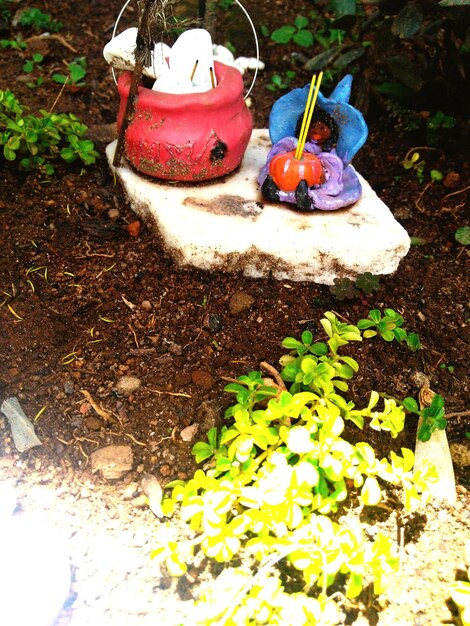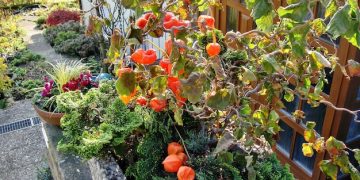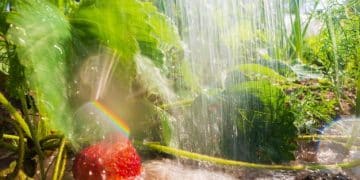Sustainable Landscaping: Your Guide to an Eco-Friendly Yard

Sustainable landscaping blends aesthetic appeal with environmental responsibility by using native plants, conserving water, reducing chemical use, and creating habitats for local wildlife, resulting in a beautiful and eco-friendly yard.
Dreaming of a lush, vibrant yard that’s also kind to the planet? Sustainable landscaping offers a way to harmonize beauty with environmental responsibility, creating an outdoor space you can truly feel good about.
What is Sustainable Landscaping?
Sustainable landscaping goes beyond traditional gardening by focusing on environmentally friendly practices. It’s about creating a yard that’s not only beautiful but also supports local ecosystems and reduces your environmental footprint.
By embracing sustainable techniques, you can create a thriving outdoor space that conserves resources, minimizes pollution, and provides a haven for wildlife. It’s about working with nature, not against it, to cultivate a landscape that’s both aesthetically pleasing and ecologically sound.
Key Principles of Sustainable Landscaping
Several core principles guide sustainable landscaping practices. Understanding these principles is crucial for creating a truly eco-friendly yard.
- Water Conservation: Utilizing techniques like rainwater harvesting, efficient irrigation systems, and drought-tolerant plants to minimize water waste.
- Native Plants: Prioritizing plants that are indigenous to your region, as they are naturally adapted to the local climate and require less maintenance.
- Reduced Chemical Use: Avoiding synthetic fertilizers, pesticides, and herbicides, opting instead for organic and natural alternatives.
- Habitat Creation: Designing your landscape to provide food, shelter, and nesting sites for local wildlife, such as birds, insects, and pollinators.
By integrating these principles into your landscaping design, you can create a yard that is not only visually appealing but also contributes to a healthier environment.

Planning Your Sustainable Landscape
Careful planning is essential for a successful sustainable landscape. Consider your local climate, soil type, and the amount of sunlight your yard receives.
Think about how you want to use your outdoor space. Do you envision a relaxing seating area, a productive vegetable garden, or a play area for children? Defining your goals will help you make informed decisions about plant selection and design.
Assessing Your Site
Before you start planting, take the time to assess your site’s characteristics. Understanding these factors will help you create a landscape that thrives with minimal effort.
- Sun Exposure: Determine which areas of your yard receive full sun, partial shade, or full shade throughout the day.
- Soil Type: Analyze your soil’s composition (sandy, loamy, or clay) and pH level to choose plants that will thrive in those conditions.
- Water Drainage: Observe how water drains from your yard after rainfall to identify areas that are prone to flooding or drought.
- Existing Vegetation: Consider how to integrate existing trees, shrubs, and plants into your sustainable design.
With a thorough understanding of your site, you can create a landscape that is well-suited to its environment, reducing the need for excessive watering, fertilization, or pest control.
Choosing the Right Plants
Selecting the right plants is crucial for a thriving sustainable landscape. Native plants are generally the best choice, as they are well-adapted to the local climate and require minimal maintenance.
Consider incorporating a variety of plants with different heights, textures, and bloom times to create a visually appealing and ecologically diverse landscape. Think about plants that provide food and shelter for local wildlife, such as berry-producing shrubs and nectar-rich flowers.
Benefits of Native Plants
Native plants offer numerous benefits for sustainable landscaping. They are adapted to the local climate, require less water and fertilizer, resist local pests and diseases, and provide habitat and food for native wildlife.
By choosing native plants, you can create a landscape that is both beautiful and ecologically beneficial. You’ll also save time and money on maintenance, as native plants are naturally low-maintenance.
Drought-Tolerant Landscaping
Also known as xeriscaping, drought-tolerant landscaping is really important in areas with extended dry periods or water restrictions. It involves selecting plants that need very little supplemental water to survive.
Succulents, ornamental grasses, and certain varieties of shrubs are suitable for xeriscaping. You can use rocks, gravel, and mulch between plants to help conserve soil moisture and suppress weed growth.
Water Conservation Strategies
Water conservation is a cornerstone of sustainable landscaping. Implementing efficient irrigation systems, harvesting rainwater, and using mulch are great ways to reduce water waste.
By adopting water-wise practices, you can conserve precious resources and create a landscape that thrives even during dry spells. Smart water use is not only environmentally responsible, but it also lowers your water bills.
Efficient Irrigation
Upgrade to a smarter irrigation system or improve your current water schedule to minimize water evaporation and water runoff. Consider installing a drip irrigation system or soaker hoses.
- Drip Irrigation: Delivers water directly to plant roots, minimizing water loss through evaporation.
- Soaker Hoses: Release water slowly and evenly, allowing it to soak into the soil.
- Smart Irrigation Controllers: Automatically adjust watering schedules based on weather conditions and soil moisture levels.
By using efficient irrigation techniques, you can significantly reduce your water consumption and keep your plants healthy and hydrated.
Rainwater Harvesting
Rainwater harvesting involves collecting rainwater from your roof and storing it in a tank or barrel for later use. This water can then be used to irrigate your garden, wash your car, or even flush toilets.
Installing a rainwater harvesting system is a great way to conserve water and reduce your reliance on municipal water sources. It’s also a sustainable practice that helps to reduce stormwater runoff and prevent erosion.

Creating Habitats for Wildlife
Sustainable landscapes can provide food, shelter, and water for a range of wildlife, from bees and butterflies to birds and small mammals. You can boost local biodiversity by including habitats for wild critters.
By creating a wildlife-friendly landscape, you can contribute to the health of the local ecosystem and enjoy watching nature thrive in your own backyard. It’s also a great way to educate children about the importance of biodiversity.
Attracting Birds
Attract colorful bird species by providing bird feeders, bird houses, and bird baths. Include plants that provide nesting material such as seed heads and dried grasses.
- Bird Feeders: Offer a variety of seeds, nuts, and suet to attract different bird species.
- Bird Houses: Provide safe nesting sites for birds.
- Bird Baths: Offer a source of fresh water for birds to drink and bathe.
By creating a bird-friendly landscape, you can enjoy the beauty and song of these feathered visitors while supporting their populations.
Supporting Pollinators
Provide sources of food and shelter for bees, butterflies, and other pollinators by planting nectar-rich flowers and providing nesting sites. Avoid using pesticides, as they can harm these beneficial insects.
You should have masses of flowering plants to support the pollinators. Choose a mix of plants that bloom at different times throughout the growing season to ensure a continuous supply of nectar and pollen.
Reducing Chemical Use
Reducing or eliminating the use of synthetic fertilizers, pesticides, and herbicides is essential for sustainable landscaping. These chemicals can pollute soil and water, harm beneficial insects, and pose risks to human health.
Opt for organic gardening practices, such as composting, mulching, and using natural pest control methods. These practices will help you create a healthy and balanced ecosystem in your yard, reducing the need for synthetic chemicals.
Organic Fertilizers
Compost, manure, and other organic fertilizers provide plants with the nutrients they need without harming the environment. They also improve soil health and water retention.
You can make your own compost at home by collecting kitchen scraps, yard waste, and other organic materials. Compost is a valuable soil amendment that can improve plant growth and reduce the need for synthetic fertilizers.
Natural Pest Control
Encourage beneficial insects, such as ladybugs and lacewings, to control pests naturally. Use insecticidal soap or horticultural oil to control aphids and other soft-bodied insects.
Avoid using broad-spectrum pesticides, as they can kill beneficial insects along with pests. Instead, focus on targeted pest control methods that minimize harm to the environment.
| Key Point | Brief Description |
|---|---|
| 🌿 Native Plants | Adapted to local climates, require less water and maintenance. |
| 💧 Water Conservation | Use efficient irrigation & rainwater harvesting. |
| 🐛Habitat Creation | Provide food and shelter for local wildlife. |
| 🌱 Reduced Chemical Use | Opt for organic gardening practices like composting. |
Frequently Asked Questions
▼
Sustainable landscaping conserves water, reduces chemical use, supports local ecosystems, and creates a more sustainable outdoor space, benefiting both the environment and your wallet.
▼
Consult local nurseries, botanical gardens, and online resources to identify native plants that thrive in your region’s climate and soil conditions, ensuring they’re well-suited for your yard.
▼
Use drip irrigation, collect rainwater in barrels, mulch around plants to retain moisture, and water your garden during the cooler morning or evening hours to reduce evaporation.
▼
Plant a variety of nectar-rich flowers, install bird feeders and houses, provide a water source, and avoid using pesticides to create a welcoming habitat for birds, butterflies, and other pollinators.
▼
Use compost and manure as organic fertilizers, encourage beneficial insects for pest control, and apply insecticidal soap or horticultural oil for targeted treatment of aphids and other soft-bodied pests.
Conclusion
By embracing sustainable landscaping practices, you can cultivate a beautiful and eco-friendly yard that benefits both the environment and your own well-being. From choosing native plants and conserving water to reducing chemical use and creating habitats for wildlife, every step you take towards sustainability will contribute to a healthier and more vibrant outdoor space.





